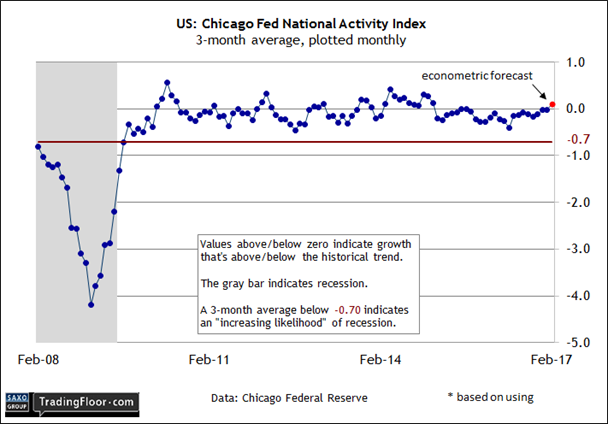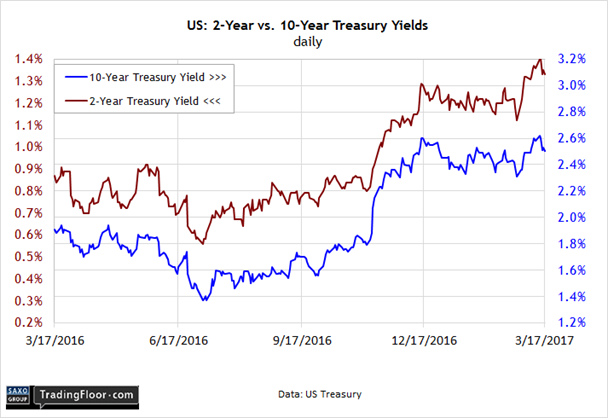- The Eurozone Labour Cost Index should edge higher in the update for Q4 last year
- That will make monetary hawks see troubling brewing on the inflation front
- The Chicago Fed National Activity Index should reflect rising US growth in February
- The 10-year Treasury yield slipped after last week’s Fed rate hike
In the wake of firmer inflation in Europe, today’s quarterly data on Eurozone labour costs will provide new context for looking ahead. For the US, the main event for economic reports today is the monthly update of the Chicago Fed National Activity Index. Meantime, the benchmark 10-year Treasury yield deserves attention after posting a decline despite a Fed rate hike and hints of even tighter monetary policy in the months ahead.
Eurozone: Labour Cost Index (1000 GMT): Consumer inflation at the headline level accelerated to 2.0% in February in year-over-year terms – the strongest pace in over four years, according to last week’s revised data. Today’s quarterly release of the Labour Cost Index (LCI) is expected to provide another clue for anticipating firmer pricing in the months ahead.
TradingEconomics.com’s econometric forecast sees LCI ticking up to a 1.6% year-over-year rate in last year’s fourth quarter, up slightly from 1.5% in Q3. If the estimate is right, LCI will advance at its strongest pace since the first quarter of 2016.
Despite the projected rebound for LCI, it’s premature to assume that the European Central Bank is losing control of inflation. True, the consumer price index is now running slightly above the ECB’s target of “below, but close to 2%.” But core inflation, a more reliable measure of the pricing trend, continues to hold steady at a much lower 0.9% year-over-year rate. In fact, the central bank will look at core inflation and conclude that pricing pressure is still sufficiently weak to warrant ongoing monetary stimulus.
Most of the attention, however, is focused on headline inflation and by that measure the monetary hawks see troubling brewing. Today’s LCI data will probably reaffirm that view, even if core CPI suggests otherwise.

US: Chicago Fed National Activity Index (1230 GMT): Economic growth has been running just below its historical trend rate in recent months, but growth appears on track to pick up in today’s February release.
The three-month average of the Chicago Fed National Activity Index (CFNAI-MA3) is expected to rise above zero for the first time in two years, based on the econometric estimate via TradingEconomics.com.
The Federal Reserve is expecting stronger growth too, or so last week’s decision to raise interest rates implies. But while the Fed continues to tighten monetary policy, the central bank’s economic forecast was left unchanged. GDP this year is expected to rise a modest 2.1%, matching the December projection.
Meanwhile, the Atlanta Fed’s revised nowcast for GDP growth in the first quarter fell to 0.9%, well below the sluggish 1.9% increase in last year’s Q4. Forecasts can be wrong, of course. But if today’s CFNAI-MA3 update turns out to be considerably weaker than expected, the Fed’s relatively upbeat outlook will look dated, even though it’s less than a week old.

US: 10-Year Treasury Yield: The Federal Reserve last week raised the target Fed funds rate for the third time since the recession ended, and dropped hints that it would continue to do so again in the months ahead, perhaps several times. But if this was a reason to sell Treasuries (and thereby raise yields), there was no sign that the bears were in control of trading after the central bank’s decision last Wednesday.
The benchmark 10-year Treasury yield ended last week at 2.50%, below the 2.60% rate on the day before the Fed announcement, based on daily data via Treasury.gov. By some accounts, yields may be headed even lower, despite the modestly hawkish bias that’s informing monetary policy.
The global chief investment officer at UBS Wealth Management on Friday advised that the bond market selling that followed Donald Trump’s election last November is nearly over. “Historically, 10-year Treasury yields have tended to peak relatively early in the Fed rate tightening cycle, as markets typically move swiftly to price in a full series of rate hikes.” Mark Haefele added that the 10-year Note looks attractive for a six-month horizon.
Perhaps, but it's reasonable to wonder how the conflict between the Fed's plans and the market’s reaction can last. One side or the other will blink eventually. Weaker-than-expected growth and/or inflation could delay future rate hikes while upside surprises on those fronts will probably trigger a new wave of selling in the Treasury market.
On that note, consider that the Atlanta Fed’s March 16 estimate for GDP growth in the first quarter slipped to a weak 0.9%, well below the sluggish 1.9% pace in last year’s Q4. But the New York Fed’s Q1 nowcast is considerably stronger, projecting a 2.8% increase. Here too there’s conflict, although it doesn't look like any resolution is imminent, thanks to the light schedule for US data this week.

Disclosure: Originally published at Saxo Bank TradingFloor.com
